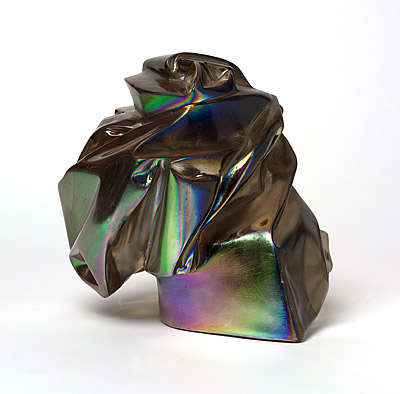John
CHAMBERLAIN
United States of America
1927
Le molé
1971
cast polyester resin, oxide coating
printer's proof I
edition of 56 plus three artist's proofs and three printer's proofs
overall
17.0 (h)
x 20.8 (w)
x 19.0 (d)
cm
Purchased 1973
National Gallery of Australia, Canberra
NGA 1973.965
© John Chamberlain, Licensed by ARS, New York and VISCOPY, Australia
John Chamberlain’s working process is based on the use of found objects or common materials, assembled into a unique ‘fit’ that is expressive of a spontaneous gesture. Le molé is a multiple created during an experimental phase of Chamberlain’s career which saw him temporarily abandon his large-scale scrap-metal sculpture. Instead, Chamberlain looked towards the chance structures of scrunched-up tissues, crumpled cigarette packets and burst paper bags for inspiration:
My work with paper bags started with me blowing up and popping a bag … I started making the sculptures. Then I felt someone might look at these … paper sculptures and think someone had merely wadded them up and forgotten to throw them away. How was I going to retain the delicacy of the paper and the delicacy of the little watercolours I put on them? So I dripped clear plastic resin down the creases, and I thought that was one of the most marvellous pieces of engineering I’d seen for a long time.[1]
Le molé is derived directly from a scrunched-up paper bag, the profile of which was cast in polyester resin and vacuum coated with an aluminium and silicon oxide. For each work in the edition,[2] the artist manipulated the thickness of the oxide and the angle from which it was applied to create nuances in the surface patina. This manual transformation of the ‘molecular’ structure of the coating may provide a clue to the work’s title. Believing that ‘You can do the same thing with words or with metal’[3], Chamberlain composes his titles by rearranging language scraps. In this way, Le molé is deliberately cryptic, a humorous word contraction that is typical of the artist.
Despite its small scale and experimental material, Le molé contains a similar sequence of detailed ‘actions’—compressions, expansions, twists, angles and stress points—that are the hallmarks of Chamberlain’s larger scrap-metal monuments.
Jaklyn Babington
Assistant Curator
International Prints, Drawings and Illustrated Books
National Gallery of Australia, Canberra
[1] J Sylvester, ‘Auto/Bio. Conversations with John Chamberlain’, in John Chamberlain. a catalogue raisonné of the sculpture, Hudson Hills Press, New York, 1986, p 17
[2] Le molé is a multiple sculpture, created in 1971 in collaboration with Gemini Graphic Editions Ltd (GEL)
[3] J Sylvester, 1986, p 11

